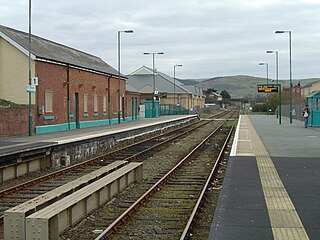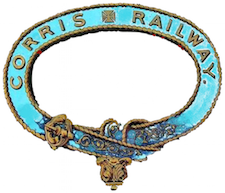Cambrian Railways owned 230 miles (370 km) of track over a large area of mid-Wales. The system was an amalgamation of a number of railways that were incorporated in 1864, 1865 and 1904. The Cambrian connected with two of the larger railways to give connections to the North West of England, via the London and North Western Railway; and with the Great Western Railway for connections between London and North Wales. The Cambrian Railways amalgamated with the Great Western Railway on 1 January 1922 as a result of the Railways Act 1921. The name is continued today in the route known as the Cambrian Line.

Pennal is a village and community on the A493 road in southern Gwynedd, Wales, on the north bank of the Afon Dyfi/River Dovey, near Machynlleth.

Aberllefenni is a village in the south of Gwynedd, Wales. It lies in the historic county of Merionethshire/Sir Feirionnydd, in the valley of the Afon Dulas.

Sir Henry Haydn Jones was a Welsh Liberal Party politician.
The Plynlimon and Hafan Tramway was a 2 ft 3 in gauge narrow gauge railway in Cardiganshire in Mid Wales. It ran from Llanfihangel station on the Cambrian Railways via the village of Talybont and the valley of the Afon Leri into the foothills of Plynlimon Fawr. It was built to serve the lead mines at Bwlch Glas and stone quarries around Hafan and opened in 1897, closing just two years later. The line was a little over 7 miles (11 km) long and despite running a short-lived passenger service, it served no communities of more than 100 people.

Machynlleth railway station is a railway station on the Cambrian Line in mid-Wales, serving the historic town of Machynlleth. It was built by the Newtown and Machynlleth Railway (N&MR), and subsequently passed into the ownership of the Cambrian Railways, the Great Western Railway, British Railways and British Railways. It is notable that there is a distance of 22 miles (35 km) between this station and Caersws, the longest distance between two intermediate stations in Wales.

There were more than a thousand British narrow-gauge railways ranging from large, historically significant common carriers to small, short-lived industrial railways. Many notable events in British railway history happened on narrow-gauge railways including the first use of steam locomotives, the first public railway and the first preserved railway.

Tywyn railway station serves the town of Tywyn in Gwynedd, Wales. The station is on the Cambrian Coast Railway with passenger services to Barmouth, Harlech, Porthmadog, Pwllheli, Aberdovey, Machynlleth and Shrewsbury.

Tal-y-llyn Lake, also known as Talyllyn Lake, Llyn Mwyngil or Llyn Myngul is a large glacial ribbon lake in Gwynedd, North Wales. It is formed by a post-glacial massive landslip damming up the lake within the glaciated valley. The hamlet of Talyllyn lies at the west end of the lake.
The Mawddwy Railway was a rural line in the Dovey Valley in mid-Wales that connected Dinas Mawddwy with a junction at Cemmaes Road railway station on the Newtown and Machynlleth Railway section of the Cambrian Railways.

Sir Haydn is a narrow gauge steam locomotive, built by Hughes's Locomotive & Tramway Engine Works of the Falcon Works, Loughborough in 1878. It operated on the Corris Railway in Wales, until closure in 1948, and since 1951 has operated on the nearby Talyllyn Railway. It has carried the operating number 3 under four successive owners.

Edward Thomas is a narrow gauge steam locomotive. Built by Kerr Stuart & Co. Ltd. at the California Works, Stoke-on-Trent in 1921, it was delivered new to the Corris Railway where it ran until 1948. After that railway closed, the locomotive was brought to the Talyllyn Railway in 1951, then restored, and remains in working order at the heritage railway. It has carried the operating number 4 under four successive owners.

Tal-y-llyn, or Talyllyn, is a small hamlet and former parish in Gwynedd, Wales, situated at the end of Tal-y-llyn Lake close to the village of Abergynolwyn. The parish covered an area of 36,000 acres (15,000 ha). The River Dysynni flows out of the lake at this point, flowing down to enter Cardigan Bay north of Tywyn.

Lewis Cozens was a British railway author and historian, notable as one of the earliest writers on Welsh narrow gauge and light railways.





















